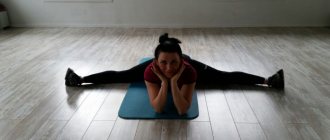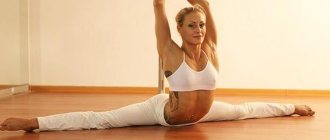The splits are a muscle stretching movement that not everyone can do. To learn how to do it, you need to perform different workouts every day that will develop stretching of muscle fibers. And to learn how to do the splits , it’s worth considering the whole training system and the rules for conducting them. You should be prepared for the fact that the process may drag on for months and sometimes years. But if you do everything correctly and persistently work toward your goal, you can soon acquire excellent stretching and flexibility.
Main principles of training
To understand how to quickly do the splits at home, you should first study the basic principles of this stretching exercise. There are two types of twine - dynamic and static. Dynamic is a vertical split (in a standing position). Static is a stretching movement that is performed in a horizontal position, sitting on the floor.
To get the desired results quickly, you must follow some principles during training:
- Begin stretching after your muscles are thoroughly warmed up. For these purposes, you can resort to such simple workouts as running, walking on steps, jumping in place or with a skipping rope. Preliminary warm-up of the muscle tissue is a prerequisite, otherwise the ligaments may rupture, and their recovery may take a long time.
- When performing, the back should be in a straight position.
- Training for beginners should be divided into two parts. In the first, you should perform exercises for dynamic splits, and in the second, for static splits.
- If training is performed in a cool room, it is recommended to wear leggings. Ligaments must be kept warm.
- The training must be done correctly. Particular attention should be paid to breathing: it should be calm, without sudden breaths or delays.
Video
General recommendations
You will be able to do the transverse or longitudinal splits only when you can develop the flexibility of your body, make your muscles more flexible and your joints more mobile. Various stretches are used for this. It is important to understand that you will not be able to comprehend the basics in a week or 10 days.
You need training, patience and the desire to work towards your goal.
The longitudinal split, when one leg is in front and the other behind, is easier to master than the transverse split (legs to the sides). There are different ways to quickly learn the twine technique from scratch at home.
Regardless of which option you choose for yourself, you need to consider simple recommendations and training tips for beginners:
- do stretching according to the system “from simple to complex”, increase the load gradually;
- choose comfortable clothes that will not restrict movement, purchase a gymnastic mat;
- exercise regularly, preferably at least 4 times a week, ideally every day;
- do not hope to do the splits in 30 days or 2 weeks, only children are capable of this, because babies are very flexible and agile;
- You need to do stretching and gymnastics for at least 30 minutes per day, preferably 45-60 minutes;
- remember safety precautions;
- listen to your body, discomfort and pain are signs that you need to stop training;
- Give your muscles and ligaments a rest, don’t overdo it, exercise for fun.
Be sure to warm up before starting classes. You can warm up your body in 10 minutes. During this time, you need to jog, jump rope, swing your legs, and do squats.
A hot shower, which should be taken 5-10 minutes before training, will help to effectively relax your muscles. When the lesson comes to an end, you need to stop gradually, walk around, jump, and stretch.
How long does it take to do the splits?
If you have decided to learn how to make twine on your own, then the question has probably crossed your mind: how long will it take? The period can be influenced by various factors - age, weight, health status.
Please note: It is worth remembering that the older a person is, the harder it will be for him to get a positive effect when learning to stretch.
In addition, it is worth taking into account the structure of the skeleton, namely the areas of the limbs, types of ligaments and bones.
Let's consider the duration of training depending on age:
- The most plastic ligaments are in children and adolescents aged 3 to 16 years. If you do regular training during this period, you can get positive results within a week.
- Between the ages of 17 and 25, stretching can be learned in 10-14 days.
- Women between 30 and 40 years old will need to work for two weeks or more. During this period, the ligaments become tight.
- It is also possible to learn the splits at the age of 40-45, but this process may take several months.
- At the age of 50, you can learn how to do the splits, but only if there are no contraindications. However, this process can take up to six months.
The speed of achieving results is influenced by a person’s physical training. If he has never worked out before and has naturally inherited poor stretching, then training may take more than one month. Don't forget about weight: excess body weight can become an obstacle to stretching.
What should you wear to a stretching session?
You can exercise in both shorts and leggings, the main thing is that you are comfortable and the material of the sports uniform has good stretch. If it's just stretching, without strength training, then you can do without sneakers.
Photo: Marya Tyagunova, “Championship”
A few tips to make the stretching process easier:
- accustom yourself to regularity, - try to relax while stretching, - breathe correctly, stretch while exhaling, - make sure that during stretching your legs are not bent at the knees (when the exercise requires straight legs) and do not hunch your back, - stock up patience! Everything will work out.
Sign up for the next free training session from Taisiya Vershinina at adidas BASEMOSCOW.
Ideal Frequency
To quickly learn how to do the splits, you need to regularly do the required training. Their frequency and quality affect the speed of obtaining positive results.
Video
To learn how to do the splits without harm to your health, you should definitely remember the following recommendations:
- It is recommended to do stretching every day.
- It is not advisable to expose muscles to stress for 2-3 hours.
- It is recommended to spend 30 minutes a day on training.
- The ideal time for exercise is 25-30 minutes in the morning and evening.
Note! If you follow the above tips and train for the specified time, then positive results can be obtained within a few months.
When is it better to postpone classes?
Not everyone can conquer the splits, and especially dream of doing it in 3 days. There are contraindications to stretching training. It is prohibited to practice if a person has:
- there are spinal injuries, ruptures of inguinal ligaments, diseases of the musculoskeletal system;
- inflammatory processes;
- a chronic disease is in the acute stage;
- joint diseases;
- muscle injuries;
- elevated body temperature.
Before devoting yourself to training, be sure to visit a doctor, get examined and consult whether you can train and stretch. If the doctor has given his consent, you need to exercise at the right time so as not to harm your body.
It is better not to eat anything 1 hour before training. Drink more fluids, review your diet. Choose positive musical accompaniment for yourself.
Be sure to be patient and in a good mood. Don’t strive to become a real gymnast in three days, and don’t be upset if results don’t appear in one month. Understand that rushing in this matter will not lead to anything good.
Approach your classes responsibly, and you will definitely achieve your goal - do the splits quickly and safely.
Necessary exercises for stretching muscles
So how can an adult learn to do the splits? First, a warm-up must be carried out: it will ensure that the muscles are fully warmed up. It should take on average 10-15 minutes. This step is mandatory; if it is not done, the ligaments can be seriously damaged in the future.
The following workouts are perfect for stretching muscle tissue:
- running in place;
- jumping using a skipping rope;
- squats;
- circular rotations with the legs - knees should be bent;
- dancing.
After this, you can perform exercises to do the splits. There are a variety of workouts that are great for self-study. But when carrying out them, it is worth observing important safety measures and precautions.
WHY DO YOU NEED SPLIT?
Twine is present in many sports (figure skating, gymnastics, etc.), in martial arts, as well as dances (strip plastic, modern jazz, pole-dance, tango, hustle, etc.).
However, stretching is not just for athletes. Stretching to the splits improves the mobility of the pelvic joint, has a positive effect on the intestines and genitourinary system, improves blood supply to the thighs, which in turn helps in the fight against cellulite. Well-stretched thigh muscles relieve stress on the joints. For example, stretching the hamstring muscles relieves stress on the knee joint, allowing for proper weight distribution when walking, which will help prevent many knee diseases (see the article “Stretching therapy or splits for heels”). A well-stretched quadriceps (the front surface of the thigh, which is pulled during the longitudinal split) will help maintain correct posture and a healthy spine. People who engage in sports and stretching age more slowly and remain healthy and active longer.
In addition to all these scientific factors of the benefits of splits for the body, there is also a simple, human one: the production of endorphin - the hormone of happiness in connection with the pleasure received from feeling your toned, flexible body. Feelings of self. There is not a single person who has a beautiful, fit, flexible body who would ask the question “Why is this necessary?”
Muscle stretching
First, it is recommended to stretch the muscles.
The training is divided into several stages:
- To begin, sit down on the floor surface. Place your legs in the shape of a V. It is advisable to spread your legs as wide as possible. After this, you should start bending with the body part, first towards the right leg, while trying to clasp the foot area with your hands. Next, you should bend to the center and to the left leg. When performing these movements, try to bend as low as possible. You should feel the muscle tissue stretching. The execution period must be at least 60 seconds.
- Next, you can begin the exercise, which is also done while sitting on the floor. The legs are folded together and straightened in front of you. After this, you need to start bending forward, while stretching your arms straight. While performing movements, try to touch your fingers to the surface of the floor or to the tips of your toes. It takes about 30 seconds to stretch the muscles in this position.
Varieties of twine types
The main types of twine are longitudinal and transverse, but there are also derivatives from them. Let's look at each type in more detail.
Longitudinal
This is a body position in which one leg is moved forward and the other back. It is more difficult for men to do the longitudinal splits due to their natural feature - the hard back surface of the thighs. It is easier to sit on a longitudinal split than on a transverse split. It can be right-sided or left-sided - along the leg that is in front.
The types of splits differ according to the sports in which they are performed. For example, there is the so-called sports twine. Its peculiarity is that the heel of the back foot should be positioned straight up, and the little toe of the front foot should touch the floor. This position stretches the inner thighs. The choreographic split is different in that the back leg is turned out, while the knee should be turned to the side, the toe is stretched. In yoga, twine is used in many asanas. The toe should reach towards the body, and the heel should press against the floor.
Transverse
With this type of split, the legs should be spread in different directions, horizontally. This type is used in ballet, choreography and gymnastics. There are situations when it is impossible to perform this type of split due to physiological characteristics of the body, for example, hip dysplasia.
Each sport has its own characteristics of performing cross splits. In gymnastics, your big toes should be pressed to the floor. In choreography, it is important to keep your knees pointing up.
Sagging
This type applies to both longitudinal and transverse twine. The peculiarity is that one leg should be placed on a hill. The pelvis is in a suspended state, thereby stretching the muscles even better. This is the most difficult type of exercise; careful preparation is required to perform it.
Lying splits
Performed in rhythmic gymnastics. To do the splits while lying down, you should lie on your back, raise one leg up so that it touches your shoulder, while the other remains lying on the floor. When performing the cross split lying down, the legs are spread apart and touch the floor. It is also considered one of the most difficult types of twine.
Dynamic split
This is a whole performance, it is often used in gymnastics, choreography and ballet. To perform, you need to run up or jump in place and do the splits in the air. Stretching and strength of the legs are important here, because you need not only to jump up, but also to move them as far as possible into the desired position.
Half twine
The simplest type of exercise is when one leg is bent and the other is extended to the side or back. This type of twine is used in fitness and yoga.
We recommend learning the splits with a professional trainer. This will reduce pain due to the fact that the training will be carried out correctly and the stretching will be gradual.
Swing your legs
To stretch ligamentous tissue, you can use leg swings; they have a positive effect on the condition of muscle tissue and strengthen its structure. It is recommended to do them in several positions - standing and lying on your side.
To begin with, it is recommended to lie on your side on a hard surface. In gyms this could be a bench or the floor. It is advisable to additionally place a fitness mat: this will prevent excessive slipping.
During training, you should do the following:
- first of all you need to lie on the floor;
- then lift one leg and hold it in one position for 20-25 seconds;
- It is recommended to do the training lying on your side; in addition, you can use your arm, which bends at the elbow, for support;
- In one approach, 25-30 swings are performed in turn on the right and left sides.
When performing the exercise while standing, you need to move your limbs to the back, front and sides. 25-30 swings are performed in each direction at a time; movements must be done in several approaches.
Video
What to avoid when preparing
The brain instinctively tries to protect us from injury, so if we stretch too quickly, the muscles will resist. It is necessary to perform all movements slowly so that your muscles are ready for it. The following are aspects to avoid:
- Don't pull too hard or too fast
- Avoid jumping or jerking as this will cause micro damage and injure tissue.
- Always breathe, as muscles need oxygen
If you are recovering from an injury, check with your doctor to see if you can still do melon exercises.
Performing spins
The ligaments should be stretched gradually, there should be no sudden movements that can lead to serious injuries. It is the rotation of the head, arms, and legs that can prepare them, they will be able to become more elastic and resistant to heavy loads. At the initial stage, it is worth starting to perform head rotations. These exercises are useful for relaxing the body and preparing for subsequent physical activity. You can perform the movements in a sitting or standing position. The head goes down, rotations should be done clockwise for 30 seconds. After this you need to change direction. Then you can start rotating your legs. Exercise is of great importance for stretching ligaments and developing muscle tissue.
To do everything right, it is worth considering the following recommendations:
- The exercise is performed while standing on the floor. The leg should be raised, but not high.
- The movements must be performed in a circle.
- The first step is to rotate the leg to the left side, and then to the right.
- After this you can change legs.
- 30-40 movements are performed at a time.
- Movements should be performed in several approaches.
Leg movements can be performed while sitting on the floor surface. At the same time, your hands are moved behind your back, they need to lean on the floor. The spine should be straight. After this, circular movements are performed; they should be the same as when performing while standing. But the leg should be raised as high as possible.
Video
To warm up the body muscles, you can perform arm rotations.
The exercise is done like this:
- First you need to stand up, close your legs together, and stretch your arms forward.
- First, the arms are held above the head, then they are spread out, they should be parallel to the floor surface.
- Then they fall down, then stretch out in front of them and rise above their heads again.
- The exercise must be performed 20 to 30 times.
Rules for safe stretching for beginners
- Know your body.
Although we are all anatomically similar, each of us has our own characteristics: the structure of the hip joint, the elasticity of muscles and ligaments. When using online guides, remember that what works for some people may not work for you. - Always warm up your muscles before stretching.
What can you do as a warm-up? Running or walking in place, lunges, squats, hip rotations, etc. 10 minutes is enough to prepare the body for stress. This minimizes the risk of injury. - In the evenings, our joints and muscles become 20% more elastic
, which reduces the risk of injury and allows us to achieve better results. Make good use of this time. Some people also prefer to stretch after a hot shower, which is also beneficial. - Gradually increase the number and size of loads.
Start with one workout every 2 days until you reach daily workouts. - Stretching is unnatural for the body.
When the range of motion is greater than normal, the muscles automatically contract to prevent injury. Learn to relax and breathe evenly while stretching - this will help you achieve your goal faster. - Drink more water.
When you don't drink enough, connective tissue can stick to muscle fibers, reducing your range of motion. - Be extremely careful with paired stretch marks.
No one but you can know what condition your ligaments and muscles are in now. In an attempt to speed up the process, you may not help yourself, but harm yourself. - Use a timer.
A simple stopwatch helps you organize your training process and track your progress. Start with 15-30 seconds, and gradually increase the time.
Thigh stretch
In order for the ligaments to stretch in a short period, it is necessary to pay attention to this type of exercise.
Video
During this you must do the following:
- To perform the workouts, the first thing you need to do is stand in a lunge - the left knee is put forward and bent at a right angle, and the right knee should lie on the floor surface.
- Using the left hand, you need to pull the foot towards the buttocks, while the groin must be lowered down.
- In order to maintain balance, you can rest your hand on the floor.
Please note: If it is difficult to support your hand, you can place books or a fitness brick under it. It is advisable to move the weight to the front leg area during training.
A set of stretching and flexibility exercises
During training, pay attention to your technique. A common mistake is a bent back. Because of it, you will not achieve any results or will be forced to deal with lower back pain. Also keep your knees straight: otherwise the workout will lose 80% of its effectiveness.
- Sit on the floor and take an L-shaped pose: keep your back straight and your legs extended. As you exhale, bend forward and touch your palms to your toes. Stay in this position for 20-30 seconds.
- Sitting on the floor, place your feet together and spread your knees out to the sides. Swing right and left, touching your knees to the floor.
- Sit on the floor and spread your legs out to the sides in a V shape as far as possible. Alternately bending to the right, then to the left, touch the foot with your hand. Hold your torso at the bottom of the tilt for 20-25 seconds.
- Stand straight, move your feet together and bend forward, trying to “fold in half.” Fix your body at the bottom of the slope for 20-30 seconds.
- Bend your left leg at the knee and extend your right leg to the side. Squat and stretch for 60 seconds, then switch legs and repeat the movement.
- Place one leg on a table, ballet barre (or other support) and do 15 squats from this position. Then turn to the other side of the machine and do another 15 repetitions.
The recommended number of repetitions for each of these exercises is 15-20 times. The estimated training time will be 40-50 minutes. Make sure that the muscles are not too tense, otherwise injury may occur.
To perform exercises, use a fitness mat: the covering will make the exercise comfortable. Pleasant music will help you relax.
Stretching while standing
If you want to know how an adult can learn to do the splits, you can use a useful exercise - stretching while standing.
Video
The workout is performed standing, legs closed. The weight is transferred to the area of the left leg, and the right one needs to be bent at the knee.
It is worth noting! The right leg is clasped with your hands and smoothly lifted up. At the same time, you should try to lift it very high and keep it straight, pulling it towards your body with your hands.
Why do you need to be able to do the splits?
- Firstly, by doing stretching exercises, you can have beautiful legs, toned thighs and buttocks.
- All these exercises strengthen the spine. You will have beautiful posture and less back pain.
- Muscles are strengthened and trained. If you fall, you will be less likely to twist your ankle or strain a muscle.
- You will become more flexible.
- Possibility to slightly lengthen the legs by 1-2 centimeters, because... you stretch your joints.
- Good for joints.
Exercise "Fold"
If you include the “Fold” exercise in the complex, then within a month you will be able to learn how to do the splits. The workout perfectly stretches the muscles of the back and buttocks, and is also great for working out the abs.
When performing the exercise, you should do the following:
- To begin, lie on your back with your legs and arms extended forward.
- At the same time, you should slowly lift your arms and legs off the floor; they need to be lifted up.
- Your knees should be slightly bent.
- You should stay in this position for 10-15 seconds, after which you can return to the original state.
- The exercise must be repeated 10-15 times.
Note! When performing the “Fold” exercise, it is important not to strain your back muscles. It is recommended to do twisting using the abdominal muscles.
If you decide to learn the splits on your own, then you should be careful when performing all the exercises. All actions should be gradual and slow; at the initial stage, special attention should be paid to the ligaments: sudden movements can lead to their rupture. It is imperative to take into account the rules and principles of training; thanks to them, you can quickly learn how to do the splits.
Contraindications to splits training
Each workout has its own contraindications. Splits are no exception, do not train if:
- thrombophlebitis;
- varicose veins 2 degrees;
- lesions of the joints of the lower extremities;
- problems with the lower back, spine;
- training should be avoided during menstruation;
- in the 3rd trimester of pregnancy.
Classes in the 1st-2nd trimester take place after consultation with the supervising doctor.
What exercises to do to do the splits
Basic splits exercises should be performed only after warming up. The order of execution is not that important. In each pose of static exercises, try to stay for 3-4 minutes.
Standing fold
Starting position: stand straight, feet together.
- We squat down and place our hands on the floor.
- Slowly lift your pelvis up, straightening your knees. We reach our nose towards the floor and our tailbone up.
For a detailed analysis of the technique for performing this exercise, watch the video:
Butterfly
Starting position: sit on the mat, spread your legs to the side and bend your knees.
- Connect your feet and move them with your hands to the groin area as close as possible without causing pain.
- Straighten your back and straighten your shoulders. Stretch the top of your head up straightening your spine.
- Try to press your knees to the floor.
- Hold this pose.
For a detailed explanation of the butterfly exercise or Baddha Konasana, see the video.
Seated fold
The seated fold stretches the back of the back, buttocks, and legs.
Starting position: sitting on the mat, legs together and straightened forward, toes pointing towards you, back straight.
- As you exhale, bend forward, trying to bend your lower back and raise your head. Grab your big toes with your fingers (if you can’t reach, put your hands on your shins). Stay in this position for a while and take a few breaths.
- As you exhale, try to spread your elbows to the sides, tilting your torso lower, try to put your face on your knees. Hold this pose for 25-30 seconds, then smoothly return to the starting position.
For detailed instructions on how to perform this fold for a beginner and a professional, watch the video:
Dynamic Lunge Stretch
Dynamic stretching will prepare the muscles for the beginner split stretch. The exercise should be performed without sudden movements, and you should not feel pain, just mild discomfort.
- Place your feet wide, turn your right foot inward and your left one outward. Bend the knee of your left leg and place your hands on the floor on either side of your leg.
- Rock your pelvis up and down, stretching your hamstrings at a pace that's comfortable for you.
- Switch legs.
- Do 10-20 movements on each leg.
Watch the video on how to do this exercise.
Exercise frog
This exercise is aimed at stretching the muscles of the inner thigh.
To perform the exercise, you will need two small pillows (towels, rags) that will slide freely across the floor.
Starting position: stand on all fours, resting your knees on the pillows (each knee on its own pillow).
- Slowly move your knees apart, sliding the pillows along the floor.
- Stay in this position for 30-60 seconds, while a deflection should form in your back.
- Then lower your elbows to the floor and stay like that for another 30-60 seconds.
- Return to the starting position.
While performing the exercise, try to relax, then the muscles will stretch better. When performing this exercise, we advise you to take your phone, magazine or book, this will make it easier for you to relax and you will be able to stay in this position longer.
In the video you can see all the nuances of performing the frog exercise for stretching the splits.
Pigeon pose
The purpose of this pose is to open the hip joints; with this exercise, the deep hip flexor muscles are stretched. By doing this exercise you will not only improve your stretching, but also strengthen your back muscles.
- Starting position: kneel, feet together.
- Place your palms on the floor.
- Push your left knee forward and lower it to the floor between your hands, with your right leg extended back.
- Straighten your back by stretching forward upward.
- Stay in this pose for 30-40 seconds, remember to breathe.
- Place your hands on the floor, push your pelvis back and sit on your heels.
- Do the exercise on the other leg.
Watch the video for the technique:
Cross split lying on your back
One of the simplest exercises that effectively stretches the inner thighs.
It's simple to do:
- lay a rug next to a free wall;
- lie on your back, trying to press your pelvis against the wall;
- spread your legs as wide as possible, it’s good if your legs slide freely along the snow;
- Stay in this pose for 2-5 minutes.
Try to relax in this position; music, audio books, etc. will help you with this. Do something at this moment or try to focus on breathing, try to disconnect from thoughts about stretching and relax.
Leg stretch from a supine position
This exercise will help stretch the muscles of the back, side and inner thighs. If you are a beginner, you will need a belt to perform this (you can take a belt from a robe).
- Starting position: lie on your back, bend your knees.
- Place the strap on your right foot and slowly lift it up. Try to fully extend your leg. Hold this position.
- Try to straighten your left leg at the knees and lower it to the floor.
- Hold this pose for 30 seconds.
- Then return to the starting position and do the exercise on the second leg.
For a detailed analysis of the exercise, watch this video:
We looked at the basic splits exercises. Now let's talk about the technique of doing the splits.
How to do the longitudinal splits correctly
When doing the splits, many people experience pain in the back of the leg that is extended forward. Often because of this, a feeling of fear arises, which clamps the muscles of the body, preventing it from moving forward. At the same time, it becomes impossible to do the splits. Therefore, it is important to correctly align the position of the pelvis and distribute the load between parts of the body.
Before you try to do the splits, be sure to do the warm-up and exercises given in this article.
Let's move directly to the longitudinal twine. To perform the exercises, you will need two pads or any other materials that will slide on the floor and two yoga blocks (you can take stacks of books as blocks, or lean on a sofa and coffee table, for example).
Place the prepared blocks on either side of you.
Let's get started:
- Get on your knee (place your knee on a pillow). The back of the foot is tucked into the floor. Place your front leg with your foot on the second pillow. The back is straight, the stomach is tucked, the chest is open, the neck is elongated. Pay attention to the pelvic bones - they should be located on the same line. The feet are hip-width apart between each other.
- Stretch your pelvic floor muscles and abdomen, inhale, and as you exhale, lower your pelvis down. Place your hands on the blocks. Move your legs apart in different directions, while making sure that your legs move in parallel lines, without leaning to one side or the other. Distribute your weight evenly between both legs.
- Reach the extreme tolerable position and freeze.
- As soon as you manage to lower your pelvis low enough, try to fully straighten your legs, while your body is extended upward. Try not only to extend your back leg, but also to twist your thigh inward. Rotating the hip inward will help relieve ligament tension in the leg that is extended forward.
- Carefully come out of the split position. Sit down, stretch your legs forward and shake your legs to relieve tension.
- Be sure to do the same on the other leg.
See video instructions below:
Reasons why you can’t do the splits for a long time
Let's talk about why you haven't been able to do the splits for a long time.
- The main reason is lack of regularity of training. If you stretch occasionally, you will not achieve results soon. Make a training schedule and try to stick to it.
- Pain when doing exercises, injuries. It happens both in the case of neglecting the warm-up, and in the case of incorrect exercise technique. We advise you to first become familiar with the correct technique for performing each exercise, learn all the nuances and possible mistakes, and only then start training. A mirror will help you monitor the correct execution of this or that exercise.
- Excessive load. Sometimes we really want to do the splits in a week and we rush to do all the exercises we can find, as a result, perhaps in an hour and a half we manage to make little progress, but the next day we can hardly get out of bed and our whole body aches (not to mention injuries and sprains that you will receive in this way), as a result we decide that stretching is not our thing. Try to do the exercises not suddenly, but gradually increasing the duration of the workout and the number of exercises.
- Holding your breath while doing exercises. When you hold your breath, the muscles do not relax, but rather tense, making it more difficult to stretch them. During training, try to breathe deeply and evenly, concentrate on breathing rather than tensing your muscles, and try to relax in each pose.
Making longitudinal twine
Longitudinal half twine. While standing, bring one leg forward and bend your knee at an angle of 90 degrees. The second leg should be straight. Place your hands on the floor. Move your pelvis up and down with a small amplitude. The exercise must be performed on each leg.
Longitudinal twine. Try doing a side split, holding for a few minutes at the lowest point you can reach. Press your pelvis down, don’t bend your knees
Move carefully, without sudden movements. Finish the exercise very carefully so as not to damage the stretched ligaments.
advertising is not displayed











